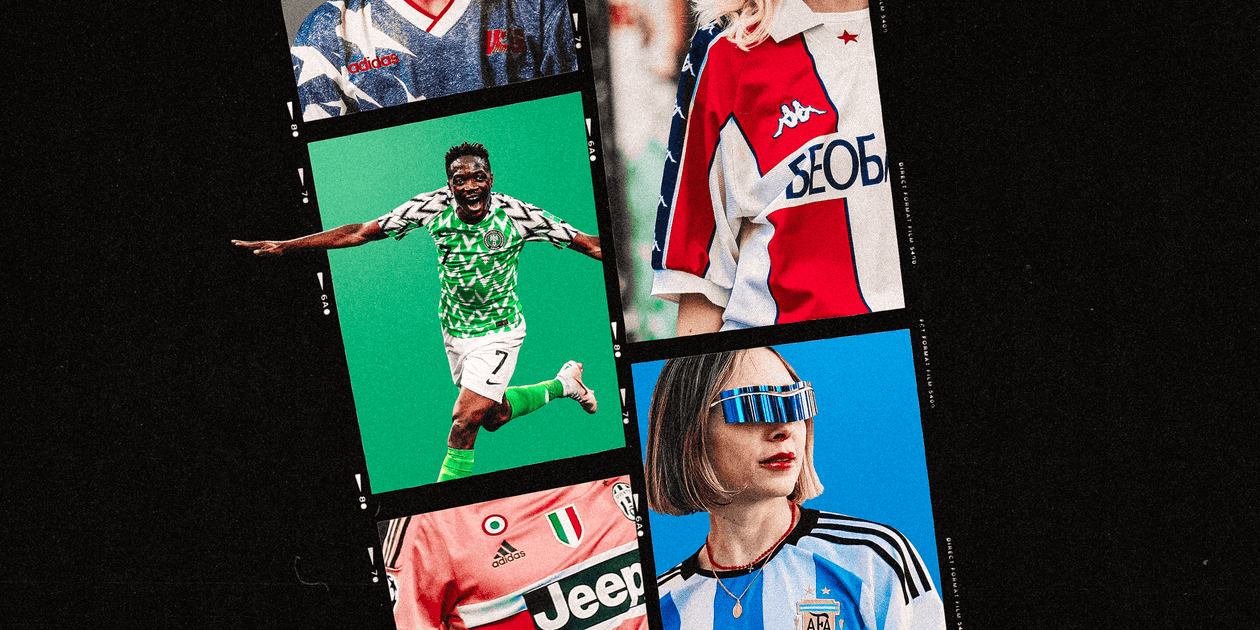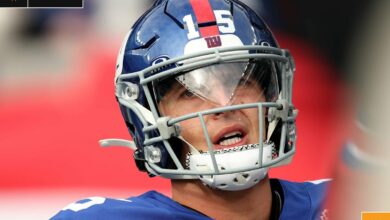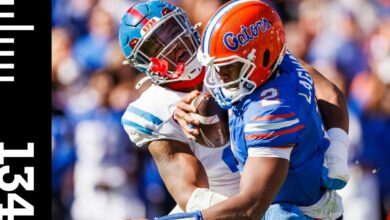From Drake in pink to ‘Blokecore’: How football shirts became fashionable

Football shirts were once an item of clothing for a) players to wear at work, and b) fans to sport on the terraces in solidarity with the lads out on the pitch.
Now, what must seem abruptly to the uninitiated, they have become the uniform for British music festivals and a source of inspiration for major fashion houses.
Several moments signalled the shift to football shirts becoming mainstream during the 2010s.
For example, Drake, the Canadian music artist, wore the 2015-16 season’s pink away shirt of leading Italian club Juventus, leading to an internet scramble from his fanbase. And two years later, the landscape changed completely again when Nigeria unveiled their kit for the 2018 World Cup finals.
“After 2016, we’d seen quite a few years of blank kits,” says Phil Delves, a kit collector, designer and influencer. “Many people rightly refer to the Nigeria kit (in 2018) and the interest around that, and I think while the design itself isn’t the craziest design we’ve seen, everything was massively amplified because of the moment it arrived and the fact it was coupled with a major tournament.”
Juventus in Pink
2015 – The latest instalment of the Juve pink kit was seen in 2015. It wasn’t just made famous by the big names, such as Pogba, on the pitch but reached a larger audience thanks to rapper Drake.
Hopefully there will be another great pink kit soon! pic.twitter.com/BGoucrstPM
— Classic Football Shirts (@classicshirts) August 2, 2018
Before Nigeria took to the pitch at that tournament in Russia, the shirt they wore as they did so had taken on a life of its own. Designed by American artist Matthew Wolff as a tribute to that African nation’s performance in reaching the knockout phase of the 1994 World Cup, in what was their debut on the global stage, the kit featured a green and white torso with triangle-patterned black and white sleeves.
The bold and vibrant design in 2018 represented the nation’s history and an emerging ‘Naija’ culture centred on a hopeful view of the country’s future, embodied by a new generation of exciting players and a growing arts sector.
Following the kit announcement, internationally famous music artists, including Wizkid, the Nigerian singer from whom Bukayo Saka has borrowed the ‘Starboy’ nickname, and Skepta, a rapper born and raised in London to Nigerian parents, wore the shirt.

Nigeria’s jersey for the 2018 World Cup was a significant moment in the scene (Mark Ralston/AFP via Getty Images)
At the same time, England were enjoying their most successful international tournament since making the semi-finals of the 1996 European Championship, and staunch and casual fans alike went shopping for retro kits to wear while watching the games.
Shortly after that 2018 World Cup, serial French champions Paris Saint-Germain announced a collaboration with Nike’s Jordan Brand worth around €200million (£168m; $223m at current exchange rates). The striking black-and-white kits produced under the deal drew eyes from around the world as global superstars in football, including Neymar and recent World Cup winner Kylian Mbappe, played for PSG in the Champions League wearing a logo associated with U.S. basketball legend Michael Jordan.
This was not the first time PSG had taken inspiration from other fashion sectors — their 2006-07 Louis Vuitton-inspired away kit was among the first of its kind — but it marked a period when the once-niche collaboration between fashion and football went mainstream.

PSG’s Louis Vuitton-inspired away kit from 2006-07 (Pascal Pavani/AFP via Getty Images)
“For us as a business, the summer of 2018 is a real turning point,” says Doug Bierton, CEO and co-founder of Classic Football Shirts. “We opened our first retail store in London, and we got to see first-hand the passion and hype.”
Classic Football Shirts started life in 2006 when Bierton and co-founder Matt Dale went searching for a Germany kit from the 1990 World Cup for a fancy dress party. After purchasing the shirt from eBay, and an England one with Paul Gascoigne’s name printed on the back, the duo noted the dearth of authentic retro jerseys available online.
Bierton and Dale set up a business to buy and sell football shirts, reinvesting their profits into new stock. Less than two decades later, Classic Football Shirts has more than 1.3 million Instagram followers, stores in major cities in the UK and the United States and expects revenues north of $50million in 2024.
Following a $38.5million (£29m) cash injection from investment firm The Chernin Group in May, the company announced several other strategic investors this month. The new investors include actor and Wrexham co-owner Rob McElhenney, recently retired USWNT legend Alex Morgan and global sports and entertainment agency Wasserman.
Bierton is as equipped as anybody to chart how the business has developed from a relatively niche collector industry into one of the most prominent subcultures within football and fashion.

A model wearing a football shirt at the 2018 Paris Fashion Week (Christian Vierig/Getty Images)
“It was much more underground,” says Bierton. “It was only after the 1994 World Cup and the advent of the Premier League that football shirts started being produced with any volume, so when we set up the company in 2006, there was a limited range to look back to. When we began, shirts from the 1980s were more fashionable — like, indie style, the skinny Adidas trefoil type.
“People weren’t buying 1990s shirts from a fashion point of view because the baggy stuff wasn’t really on-trend. It was more ‘I want to get a David Beckham shirt because I’m into shirt collecting or just football in general’. But as the years go by, kids get older. People are harking back to different eras.”
Still, diehard football fans are only a portion of the industry.
Over the years, high-end fashion brands including Giorgio Armani, Dior, Stella McCartney, Yohji Yamamoto and Balenciaga have partnered with football teams to design special kits. Celebrities with no apparent ties to the sport, such as pop stars Rihanna and Sabrina Carpenter — the latter wore an England shirt over a Versace dress at the ‘Capital Summertime Ball’ festival in the UK during the recent Euros — have jumped on the hype train.
With the rise of ‘Blokecore’, an internet trend popularised on TikTok where people of all ages and genders wear retro football shirts with casual outfits, there are no limits on who wears these kits or where.
“We did a string of pop-ups in the autumn in the U.S. last year, and the turnout was insane,” says Bierton. “We had lines down the block in Los Angeles, New York and Miami.
“It was unbelievable to see the range of stuff people were wearing. It was a combination of hardcore fans who loved the game and wanted a shirt to show their knowledge and passion and those who think football shirts are pretty cool to wear. We had someone ask a customer why they were wearing an old Sheffield Wednesday shirt, and they responded, ‘I don’t even know what Sheffield Wednesday is!’.”

Some old football shirts are worth more than others (Adrian Dennis/AFP via Getty Images)
As the industry has grown, the chances of strolling into a charity shop and finding a rare shirt with a unique design have significantly declined.
People are far more conscious of the cost of used football shirts, and resellers and larger third-party retailers have increased the prices to reflect the demand. In some cases, legitimate good quality shirts in adult sizes, like the Netherlands kit from their victorious 1988 Euros campaign, can fetch more than £1,000 ($1,300). An authentic USMNT “denim” pattern shirt, worn by the host nation during the 1994 World Cup, regularly demands prices above £500.
Coupled with the increasing prices of contemporary shirts, which typically range from around £60 to £80 for the ‘replica’ version to more than three figures for the ‘player-issue’ versions produced for Premier League clubs, sales of fakes are now on the rise. According to Corsearch, a global leader in trademark and brand protection, the online market for counterfeit football shirts for Premier League clubs has risen to £180million per year.
“In the past two or three years, there have been a lot more fakes knocking about,” says Jack Mcandrew, owner of Sound Trout, an online independent vintage retailer. “It’s due to social media and the influencers who have been wearing football shirts, in some cases even wearing fakes themselves without realising, indirectly increasing the demand and creating opportunity.
“I’ve come across a lot, even from sellers who I know to be reputable. But because the shirts are so in demand and the quality is so high, people fall for them. It’s funny, because the factories that make the fakes aren’t even just doing the ones that are considered cool and coveted, like the Atletico Madrid home shirt from 2004-05 with the Spider-Man kit sponsor, they also do random generic ones.
“I’ve had to be a lot more careful. If a shirt is from the 1990s and it’s in ‘mint’ condition, nine times out of 10 it’s probably too good to be true.”

Authentic USMNT “denim” pattern shirts, worn during the 1994 World Cup, regularly demand prices north of £500 (Ben Radford/Getty Images)
For independent store owners like Mcandrew, the growing counterfeit market means they have to be extra careful when buying shirts from online outlets or inspecting in person at car-boot sales.
Classic Football Shirts, which operates a significantly larger operation with more than 160 employees, has staff responsible for sifting through fakes and procuring legitimate retro classics from all corners of the planet.
“We’ve got a rigorous authentication process,” says Bierton. “This includes looking at labels and product codes and comparing them to shirts we have. We used to have a thick written manual, and now it’s computer-based, but we have a team of around 20-odd people working on the process. It gets more challenging, particularly with the quality of fakes now produced, but once you’ve worked here for a couple of months, you can usually tell the difference.
“It’s still the case that over half the classic shirts are sold to us by people through the website. But there are crazy jobs within the company, basically hunters, whose role is to go out and find shirts in the wild for us. They go around the world, making connections to find old shirts.”
As the trend has popularised, it has become more of an international industry. While there have always been collectors worldwide — Classic Football Shirts sold its first jersey to a Liverpool fan in Norway and has had interest from “hardcore” kit enthusiasts from South Korea since its inception — subcultures have developed reflecting specific interests within populations.
“Particularly in the U.S., many fans are drawn to ‘hero printing’,” says Bierton. “It’s about players as much as teams. I think of the U.S. customers as similar to myself regarding Italian football of the 1990s. I wouldn’t necessarily support any of the teams, but I love the idea.
“I would have a Parma shirt, a Sampdoria shirt, a (Gabriel) Batistuta, (Francesco) Totti or (Roberto) Baggio shirt. That’s the Premier League to a lot of fans from the States. They might like Thierry Henry, Wayne Rooney or Sergio Aguero. They tend to be more interested in the technical aspect in Asia, preferring the player-issue shirts.”
The 1990s remain the golden era for long-time shirt collectors and those who have immersed themselves in the trend more recently. Manchester United and England tops with Beckham’s name printed on the back are among the most popular on Classic Football Shirts, competing with Cristiano Ronaldo and Lionel Messi ones.
With the introduction of ‘icon’ cards on the Ultimate Team mode of the EAFC video game, legends of the era such as Zinedine Zidane and the original, Brazilian Ronaldo have maintained their relevance to younger generations, and their shirts remain some of the most coveted.

Football in 1997 – when players’ shirts were definitely baggier (Alex Livesey/Allsport)
“The ’90s is the high water mark,” says Bierton. “There’s much more freedom of expression in the kits. They’re bolder, and they’re baggy. It’s not ‘Fly Emirates’ on the front of the shirt; it feels pre-commercialisation. It feels like there is still something pure about these shirts.
“There’s something about the 1990s and early noughties that has managed to capture the imagination of younger generations.”

GO DEEPER
A 1989 Liverpool kit and Beckham’s underpants: Why U.S. investors have bet £30m on retro football shirts
(Top photos: Getty Images; design: Dan Goldfarb)




